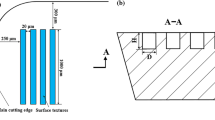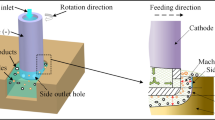Abstract
The drilling of holes with an l/d-ratio greater than 12 is responsible for a significant amount of the overall production time and therefore has a high impact on the productivity. In the past gun drills were used for those higher l/d-ratios, providing good surface qualities and straight holes. However the productivity of gun drills compared to solid carbide twist drills is very low, due to the limited feed rate. With the use of solid carbide twist drills with l/d-ratios up to 40 and overall lengths up to 350 mm production time can be reduced extensively. Solid carbide twist drills can furthermore be used on standard machine tools. Former drilling tests show that the tool life of these drilling tools decreases abundantly clear with an increasing tool length. This paper presents the influence of the drill length and the dynamic behaviour of the drilling process on the wear behaviour of the drilling tool.








Similar content being viewed by others
References
König W, Klocke F (2002) Fertigungsverfahren—band 1, Drehen, Fräsen, Bohren, VDI-Verlag, Düsseldorf
Abele E et al (2004) High speed cutting—technological performance and hints to overcome. CIRP international conference “High Performance Cutting (HPC)”, Aachen
Schulz H (2001) Scientific fundamentals of HSC, Carl Hanser Verlag, München
Tönshoff HK et al (1998) Prozesssichere Trockenbearbeitung mit TiAlN - beschichteten Werkzeugen. VDI-Z Special Werkzeuge
Tschannerl M et al (2003) Noch viel ungenutztes Potenzial beim Bohren. Werkstatt und Betrieb 136:55–57
Bayly P et al (2001) Theory of torsional chatter in twist drills: model, stability analysis and compositions to test. J Manuf Sci Eng ASME 11:552–561
Himburg T (1988) Die Dynamik des Bohrvorgangs als Grundlage eines Überwachungskonzeptes. Dissertation Technische Universität Hamburg-Harburg
Stone E, Campbell SA (2004) Stability and bifurcation analysis of a nonlinear DDE model for drilling. J Nonlinear Sci 14(1):27–57
Weinert K, Kersting M (2005) Konzeption eines adaptronischen Werkzeughalters. wt Werkstattstechnik online, 95 H. 1/2, pp 68–72
Rondé U (1994) Untersuchungen von Systemen zum Spannen von Zylinderschaftwerkzeugen unter besonderer Berücksichtigung ihrer Eignung für die Hochgeschwindigkeitsbearbeitung. Dissertation Technische Hochschule Darmstadt, Carl Hanser Verlag, München, Wien
Author information
Authors and Affiliations
Corresponding author
Rights and permissions
About this article
Cite this article
Abele, E., Ellermeier, A., Hohenstein, J. et al. Tool length influence on wear behaviour of twisted carbide drills. Prod. Eng. Res. Devel. 1, 51–56 (2007). https://doi.org/10.1007/s11740-007-0029-5
Received:
Accepted:
Published:
Issue Date:
DOI: https://doi.org/10.1007/s11740-007-0029-5




